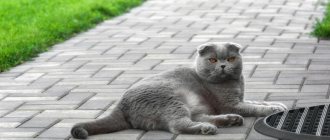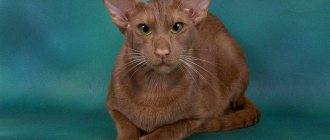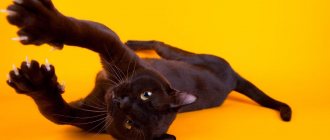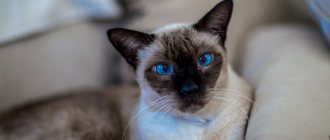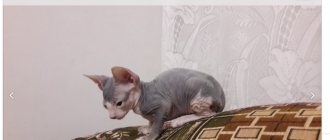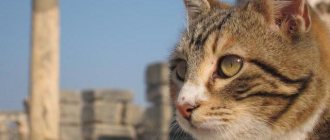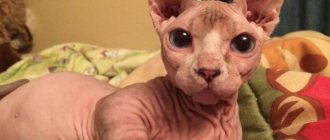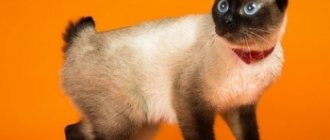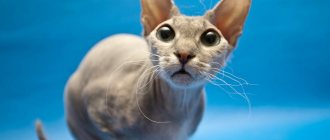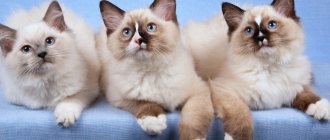Who invented the munchkin
Dachshund cats are now increasingly called munchkins. Well, they really are similar. But a little less than a hundred years ago, when the first mentions of these strange animals with short legs had just appeared, the Germans usually called them... kangaroo cats.
Here it is, the famous munchkin pose - sitting on its hind legs
Curious cats want to know everything and see everything around them, but their small stature limits their view. Smart animals have found a way out of the situation - they simply sit on their hips, resting their tail on the floor for safety: I sit well, I look far away. This is the famous “Munchkin pose”, which all other, longer-legged cats cannot do.
The Munchkin can sit in a “column” for a very long time: he stretches his neck, dangles his small paws - at this moment he really looks like a kangaroo.
History of the breed
Amazing cats appeared in different European countries and gave birth to the same short-legged offspring, which gave felinologists the opportunity to regard this as a consequence of a mutation. Enthusiasts set about creating a new breed and, undoubtedly, would have achieved success along this path if it had not been interrupted by the Second World War. The predecessors of the breed were also in Russia under the then conventional name “Stalingrad kangaroo cats”.
Selection work was interrupted for several decades, but the short-legged cats categorically disagreed with this and decided to make themselves known again. This time - in the United States of America, in Louisiana. As often happens, it all started completely by accident. Even the exact date of the breed’s history is known - 1983.
A music teacher and just a kind woman named Sandra Hochenedel found a pregnant cat with unnaturally short legs under her old truck. Sandra attributed this circumstance to a difficult life, wanderings and illnesses; she took pity on the unfortunate animal and sheltered it in her car. Soon the black and white cat, named Blackberry, gave birth to offspring. To the surprise of the owner, the kittens also had short legs.
This is what the cat Ezhevichka, the ancestor of the munchkins, looked like
Experts have taken a specific interest in the unusual kittens. They found out the main thing: the stable mutation that the Blackberry cat passed on to its heirs, and subsequently its children, in no way harms their health. American felinologists have done a great job of creating a new breed, which, by the way, received a lot of criticism at first. But the incredible charm of the short-legged people won out. Already by the beginning of the 90s, the fashion for unusual cats broke out in Europe, and then in Japan.
They were called munchkins - in honor of the little fairy-tale people from the famous book “The Wizard of Oz” by the American children's writer Lyman Frank Baum. This story is better known to us as “The Wizard of the Emerald City” in a free retelling by Alexander Volkov. In the original, a hurricane transports the girl Dorothy, along with her dog Toto and the house, to the Land of the Munchkins - the land of short munchkins, where the events of the fairy tale unfold.
Long-haired munchkins were the first (in 1995) to receive official recognition - the International Association of Cat Fanciers approved the breed standard. And the “pioneer” of the breed in Russia was a cat named Mimi Mee Pocket Herkules, brought from South Africa in 2001.
Video: descendants of the cat Ezhevichka
Breed Features
Munchkins leave few people indifferent. They are so unusual that the first impression of meeting them is usually either surprise or... pity. It may seem uncomfortable for them to walk, much less run. But nothing of the kind - the mutation has absolutely no effect on the health or mobility of these animals. Short-legged animals even find a lot of advantages in their special anatomy and are constantly in a great mood.
A mutation of this kind is by no means unique among domestic animals - on its basis such well-known breeds of dogs as the hunting dog (dachshund) and the shepherd dog (Welsh Corgi) have long been bred.
The munchkin and dachshund have short legs of a similar nature.
Anatomy and appearance
The main distinguishing feature of munchkins' appearance is, of course, their short legs - their legs can be two or even three times shorter than those of other breeds. And in almost everything else, these are ordinary cats, very diverse in color. The standard defines two types of hair for this breed - long and short; in long-haired cats, tassels on the tips of slightly rounded ears are acceptable. The body and neck are strong, well muscled, slightly elongated. The tail is not too long and thick; munchkins balance it very skillfully.
Munchkins are absolutely adorable
The Munchkin is a medium-sized cat, even the most well-fed of them will not weigh more than four to five kilograms. Accordingly, the height of these animals is small - up to 15 centimeters at the withers. The hind legs are slightly higher than the front ones, due to this, when running, munchkins touchingly wag their “fifth point”, like ferrets, and click their claws like hedgehogs. They move surprisingly fluidly, harmoniously and quickly, conquering the most unexpected places in the house for their games.
A tortoiseshell cat named Liliput was even included in the Guinness Book of Records for her small stature - in October 2013 she was recognized as the shortest domestic cat (13.34 centimeters at the withers); This American record holder comes from California.
The famous Lilliputian cat, listed in the Guinness Book of Records, was only 13.34 centimeters tall at the withers.
Character and behavior at home
The character of munchkins is beyond praise. It’s hard to even imagine a cat that is more positive and disposed towards its owner. These animals are self-sufficient and unobtrusive, but they are interested in people in the grandest sense - munchkins are attached to their adored owner not like cats, but like dogs; They train well and even train well, which is a rare quality for other breeds.
Ideal companion cats, they are easy-going and ready to accompany their owner on voyages around the world, joyfully accepting changes and without losing their always good mood.
Munchkin - a cat with an ideal character
They are intelligent, intelligent and quick-witted, they never lose heart and find things to do for themselves. They love toys very much - and not only play with them, but also... collect them. A remarkable property of munchkins is the complete absence of aggression and very high adaptability. Sociability and enviable patience allow them to easily find a common language with other pets and get along well with small children.
Table: pros and cons of the Munchkin breed
| Breed Features | Advantages | Flaws |
| Character | Friendly, patient, flexible, very balanced | Sometimes they are too inquisitive |
| Behavior | Calm, absolutely non-aggressive | He is guilty of hoarding - he makes hiding places for various small items. |
| Feeding | With a properly structured diet, you can feed both natural food and high-quality dry food. | Do not overfeed - munchkins are prone to obesity |
| Reproduction | Good playability | The selection of a pair for breeding should be carried out by specialists |
| Health | Strong immune system | Susceptibility to genetic diseases and lordosis - due to overeating |
Video: munchkin cat in the house
Buying a kitten
Munchkins were and remain a rare breed - kittens are expensive, especially if they are of interest for exhibitions and breeding work. The cost of a breed- or show-class animal starts at a thousand dollars, but a breed defect, of which there are many, can be purchased much cheaper. Therefore, when thinking about this particular breed, you should objectively weigh your ambitions and capabilities, decide: do you want a cute baby just for fun or do you intend to seriously engage in breed activities.
How to choose a kitten
Munchkins are quite rare in Russia. There are only three nurseries registered with TICA and WCF. In addition to them, there are nurseries in Moscow, St. Petersburg, Novosibirsk, Vladivostok and some other cities. Therefore, if you want to get this cat, try to visit exhibitions where they are presented. Prices for kittens with a pedigree start from 20 thousand rubles - these are animals for castration. Kittens that will be used for breeding are much more expensive. Kittens with non-standard limbs (of normal length) are lost almost for nothing. But they will have a pedigree and, as already mentioned, carry the breed-forming gene, that is, they can be bred.
When choosing a munchkin kitten, first of all you should pay attention to the back and limbs
It is better to buy a munchkin kitten that has grown up to two and a half to three months. When choosing a pet, be sure to carefully examine its back, which should be smooth, mobile and flexible. Also inspect the limbs: the bones should not be too wide. The front legs should be straight, strong and of the same thickness along their entire length.
Of course, the main feature of a munchkin is short legs, but, as already mentioned, in one litter there are approximately equal numbers of short-legged and long-legged kittens. The short-legged ones are the standard, and the long-legged ones are the straight ones. The latter are also munchkins, they will give birth to short-legged babies, but they are very cheap. After all, if a person wants to buy a munchkin, he has in mind a kitten with short legs, and is not going to explain to everyone that this ordinary-looking cat is actually a munchkin.
Munchkin kittens from the same litter can differ in paw length: on the left - straight (long-legged), and on the right - standard (short-legged)
The joints and vertebrae of munchkins are usually mobile, but you should make sure that the nursery has not reported cases of osteochondrodysplasia (a malformation of bone and cartilage, leading to a lack of normal growth of bone tissue and to its deformation).
Keeping a pet
Despite the striking unusualness of the young breed, munchkins are called cats for beginners - keeping them is not at all difficult and does not require any special training.
Feeding
Every munchkin, by definition, is a gourmet and a glutton, his sense of satiety is dulled. Due to an oversight of the owners, animals often become obese, which has a bad effect on the functions of the cardiovascular system and musculoskeletal system. A correct, balanced diet must be strictly observed when feeding representatives of this breed.
Proper nutrition is especially important for the munchkin, who has a dull sense of fullness.
Short-legged cats have an excellent appetite; they are not capricious when it comes to food. The owner’s personal choice is how to build a menu for the munchkin: whether to base it on natural nutrition or on high-quality ready-made food. But if you create your pet’s diet yourself, follow a few simple rules:
- protein should account for up to 80 percent of the diet - this is the basis of a healthy munchkin diet;
- create a main menu of fresh lean meat, poultry and boiled fish;
- organize feeding in fractions - four times a day in small portions;
- foods and all sorts of “goodies” from the human table are harmful to the munchkin.
Hygiene and grooming
Caring for a Munchkin's coat is not particularly difficult. It is enough to brush a short-haired cat weekly, a long-haired cat somewhat more often, keeping the hair clean and tangle-free. During the period of seasonal molting, it makes sense to make combing a daily procedure.
For regular hygienic combing, a small fine-toothed comb will be enough. To keep the shedding coat in order and speed up its renewal, it is recommended to use a furminator.
Munchkins do not like to swim, however, they should be thoroughly washed with a special caring shampoo as their coat becomes dirty, but at least once every two months. Care for claws, ears and eyes is normal, as for all domestic cats.
Exercise
For these cats, it is especially important to maintain their body muscles in good shape. Active indoor games may not be enough, and physical inactivity is truly dangerous for munchkins - they love to eat delicious food too much. To prevent your pet from becoming overweight, teach him to take regular walks on a harness. Such exercise is very beneficial for the health and good physical condition of the cat and, in addition, will give her great pleasure: munchkins are incredibly inquisitive and love new experiences.
A sedentary lifestyle is contraindicated for the Munchkin.
Character and behavior
These cats have a surprisingly easy character. They look at the world like children - with their eyes wide open and not expecting a catch. They love active games, and their short legs do not prevent them from making dizzyingly high jumps and racing throughout the apartment. This playfulness remains with them until death.
Curiosity is one of their main traits. Munchkins especially love small objects that can be rolled and carried from place to place. So keep in mind: if your favorite flash drive or lipstick has disappeared from the table, ask your restless pet for the item.
There is not a drop of aggression in these cats. Both adults and children are friends and buddies for them, from whom cats expect only affection. Munchkins are not afraid of strangers and are happy to go out to meet guests. They are very careful with children and do not allow themselves to let out their claws, even if they are hurt.
Travels (even long distances) stand up well. If the beloved owner is nearby, the cat will easily endure both the trip and the flight. And he adapts quickly to a new place.
They get along well with other animals, do not show aggression towards creatures smaller than themselves: fish, birds and rodents, but in case of danger they can quite stand up for themselves.
They quickly get accustomed to the tray, eat carefully and in general are very clean animals. They don’t damage the furniture, provided they have a comfortable scratching post. Regarding the tray: buy a deep and wide container. A diligent munchkin, in an attempt to bury waste as deeply as possible, can litter the floor.
A funny feature of munchkins leaves no one indifferent: if the cat wants to look at something, it tucks its tail under itself and sits in a “column”, like a gopher. Moreover, a cat can sit like this for a very long time (the physiology of munchkins allows them to do this without harming themselves).
In the eyes of other cats, a short munchkin may look like it is preparing to attack, so do not let it out of sight while walking, and even more so, do not let it walk alone. This can be extremely dangerous.
What does this pose mean in cats: crouching to the ground, arching their back, starting a mournful song?
Mating gamesPreparing for a fight
Veterinary
All the many advantages of munchkins - both their external charm and wonderful character - fade into the background if the animal is unhealthy. It is important not only to choose the right pet for yourself that is strong and disease-resistant, but also to constantly maintain it in optimal physical shape. And here a lot depends on the owner - on proper maintenance of the cat at home and qualified veterinary care.
Breed defects and diseases
Munchkins who lead a sedentary lifestyle are at risk. At the same time, against the background of regular overeating, such an unpleasant and dangerous disease as lordosis can develop. Burdened with excessive loads, the spine bends beyond measure, internal organs are subjected to pressure and even deformation. To avoid pathology, you just need to promptly provide the animal with a normal diet and physical activity, and also visit a veterinarian from time to time for preventive examinations.
Pay close attention to your pet's posture
Breeding munchkins
Breeding work on munchkins should be planned by experienced specialists, taking into account the genetic characteristics of this young breed. The fact is that the short legs of the breed are determined by the presence of the achondroplasia mutation gene. In each litter, both short-legged (standard) kittens are born, as well as ordinary, long-legged (non-standard) kittens - but nevertheless, they are also munchkins, which is why they receive the corresponding pedigree.
Matching
Properly selecting a parent pair is extremely important when breeding munchkins. The gene pool of this breed is still quite small, and breeders need to have considerable knowledge and experience so that breeding work is aimed at improving the munchkin population.
To obtain full-fledged offspring, blood from standard and non-standard sires is usually combined. As a result of such mating, it is possible to obtain a complete litter, both quantitatively and qualitatively. European felinological organizations prohibit breeding munchkins with representatives of other cat breeds that have genes for short tails or fold ears - such a combination can be fatal for the offspring.
Interestingly, if both parents are short-legged, they will have a quarter fewer children. The mysterious phenomenon of natural elimination will come into force - embryos that have received achondroplasia genes from both parents will simply dissolve in the womb. When mating two long-legged munchkins, only non-standard offspring can be born.
Preparation for mating
When a breeding pair is formed, the producers need to be prepared for mating in a timely manner. No later than a week before, the treatment of animals against fleas and worms must be completed. Future parents should be vaccinated in advance against infectious diseases, chlamydia and lichen.
Mature animals that are in good physical shape and have excellent health indicators are allowed for mating. Mating takes place on the third day of estrus; for reliability, mating is repeated one or two more times. The first mating of a breed-class cat should take place around the age of one and a half years. No more than three successful matings are allowed within two years.
The purpose of breeding work is the development and improvement of the breed
Pregnancy and childbirth
At the usual time for cats, after nine weeks, the long-awaited kittens are born. They are blind, deaf and absolutely helpless, but they grow very quickly and by the age of one and a half months they can already feed themselves and learn the rules of behavior in the house. All this time, a caring mother is engaged not only in feeding and hygiene of her babies, but also gradually, in a playful way, introduces them to the wisdom of adult life.
A newborn munchkin can be immediately distinguished from any other cat - the baby's front legs seem unnaturally oriented relative to each other. The more pronounced this breed trait is, the shorter the legs of an adult animal will be.
Castration and sterilization
The fundamental decision to sterilize your pets can be made either at the request of the breeder or for medical reasons. Carefully weigh the pros and cons of the operation and its possible consequences for the health of the animal. The optimal age for sterilizing a cat is seven to eight months; for castration of a cat - from eight months to a year.
Care instructions
There is nothing difficult about caring for munchkins.
Wool
Long-haired cats are brushed 2-3 times a week using a brush with natural bristles or rubber teeth. For individuals with short hair – once a week. The resulting tangles can only be removed with scissors.
Bathing
Bath – once every 3-4 months, using a special cat shampoo (“Bars”, for example, or “Clandestine”). Frequent bathing leads to dermatitis appearing on delicate skin. You should also not dry it with a hairdryer; just wipe the cat thoroughly with a towel.
Claws
If your pet is actively sharpening its claws, it does not require help. Otherwise, carefully trim the tips of the claws with a special nail clipper (or nail scissors), being careful not to damage the vessels inside the plate.
Ears and teeth
Ears and teeth are cleaned 2 times a month. For the ears, pick up a lotion at a veterinary pharmacy or buy chlorhexidine at a regular pharmacy; for teeth, a special cat toothpaste (Trixie, Beaphar Toothpaste, Hartz). You don’t have to spend money on a special toothbrush: just buy a children’s brush with soft bristles and trim it a little. In extreme cases, a piece of gauze wrapped around your finger will do.
Human products - shampoos, gels, pastes - are absolutely not suitable for cats. The components they contain can cause serious health problems, ranging from allergic reactions to severe poisoning.
Munchkins prefer to sleep in closed houses. Therefore, buy a bed with a closed top or cover its basket with a warm blanket.
If you forget to make such a shelter, don’t be surprised if one day you find a “nest” somewhere behind the sofa or in another secluded place. Moreover, the munchkin will try to steal more soft things for him: for example, your stole, fur gloves or a woolen blouse.
